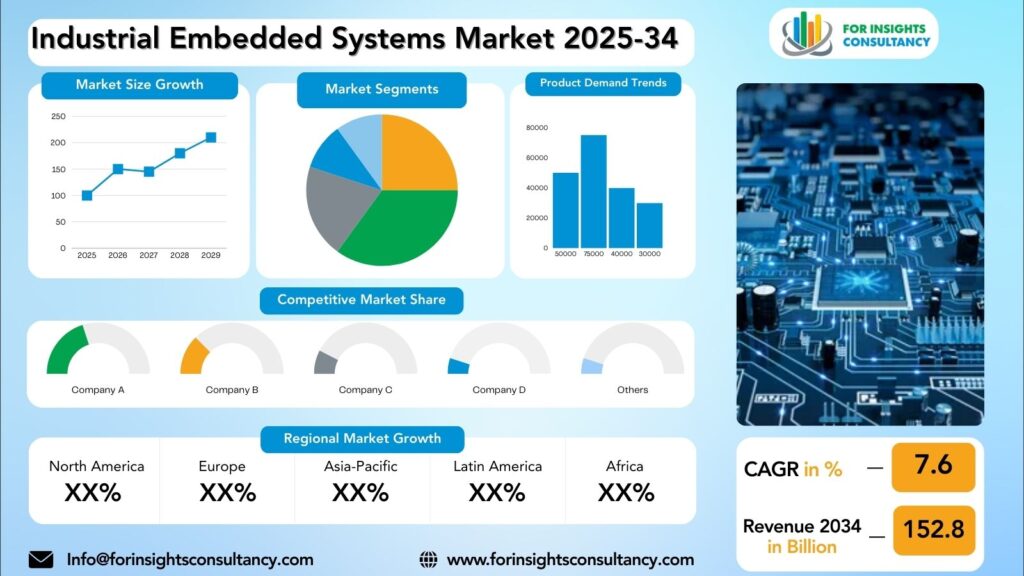
Industrial Embedded Systems Market Research Report by Technology (Artificial Intelligence (AI), Internet of Things (IoT), Machine Learning, Cloud Computing, Edge Computing), By Function (Real-time Systems, Standalone Systems, Networked Systems, Mobile Systems), by Component (Hardware (Microcontrollers, Microprocessors, FPGAs), Software (Operating Systems, Firmware), Services), by End-Use Industry (Automotive, Industrial Automation, Healthcare, Consumer Electronics, Telecommunications, Aerospace and Defense, Energy), and Region Global Market Analysis and Forecast, 2025-2034
Aug-2025 Formats | PDF | Category: Electronics & Semiconductor | Delivery: 24 to 72 Hours
Industrial Embedded Systems Market is forecast to increase from USD 98.6 Billion in 2025 to USD 152.8 Billion by 2034, at a CAGR of 7.6%.
Industrial Embedded Systems Market: A Comprehensive Overview and Future Developments
Industrial embedded systems are specialized computing devices that are integrated into larger systems to perform specific tasks or functions. These systems are ideal for use in manufacturing plants, power plants, transportation systems, and other industrial settings, ensuring smooth operation of processes. They play a key role in collecting and analyzing data, allowing companies to make informed decisions and optimize operations.
The industrial embedded systems market is expected to experience significant growth and innovation in the future. Key developments include 5G integration, Industry 4.0 initiatives, and customization and flexibility. 5G technology will revolutionize communication for industrial applications, while Industry 4.0 principles, automation, data exchange, and smart technology will drive demand for advanced industrial embedded systems. Manufacturers will increasingly demand flexible and customizable systems to meet their specific requirements and industry standards.
In conclusion, the industrial embedded systems market is a dynamic and rapidly evolving sector that drives innovation and efficiency across various industries. Companies can harness the power of these systems to optimize their operations and maintain a competitive edge in the market.
Industrial Embedded Systems Market Dynamics
Growth Drivers
The industrial embedded systems market is experiencing significant growth due to the increasing demand for automation across various industries. Companies are adopting automated systems to streamline operations, improve productivity, and reduce costs. These systems enable real-time control and monitoring of processes, enabling automation. The rapid advancements in IoT and Industry 4.0 have fueled the adoption of these technologies, enabling seamless connectivity and data exchange between devices, paving the way for smart factories and intelligent automation systems.
In today’s competitive business landscape, companies are focusing on enhancing productivity and efficiency. Industrial embedded systems help organizations achieve these goals by optimizing processes, minimizing downtime, and improving overall operational efficiency. The complexity of industrial applications is on the rise, driving the need for more advanced and specialized embedded systems.
Cybersecurity is also a growing priority for organizations, as the proliferation of connected devices in industrial settings increases the need for secure embedded systems. As technology continues to evolve, industrial embedded systems will play a crucial role in shaping the future of industrial automation. Trust in our expertise and experience to deliver cutting-edge solutions that drive your business forward. Contact us today to learn more about our innovative offerings and how we can help you stay ahead in today’s competitive market.
Restraints
The industrial embedded systems market faces several challenges, including high implementation costs, complexity of integration, security concerns, limited scalability, and regulatory compliance. Implementing these systems can be costly, requiring significant investment in hardware, software, and technical expertise. Integration can be complex, leading to delays and increased costs. Security is a major concern, as it ensures the integrity and confidentiality of data transmitted through these systems. Limited scalability can limit the system’s ability to adapt to new technologies or expand business needs. Compliance with industry regulations can add complexity to system design and implementation, and increase costs associated with certification and testing.
To address these restraints, companies can invest in research and development, focus on cybersecurity measures, collaborate with industry partners, and adopt scalable solutions. Research and development can help develop more cost-effective and scalable embedded systems, while cybersecurity measures can mitigate risks associated with data breaches and cyber attacks. Collaborating with industry partners and suppliers can streamline the integration process and provide valuable insights and resources for successful system deployment. Choosing scalable embedded systems that can easily adapt to changing requirements can help companies future-proof their investments and ensure long-term sustainability.
Opportunities
Industry 4.0 has revolutionized manufacturing and production processes, enabling smart factories and automation. Industrial embedded systems are at the core of this digital transformation, offering opportunities for businesses to streamline operations, improve efficiency, and drive innovation. The increasing demand for IoT devices is driving the demand for advanced industrial embedded systems, which enable real-time data processing, remote monitoring, and predictive maintenance. The integration of AI and ML algorithms in these systems is enhancing operational capabilities and driving business growth. Cybersecurity is a top priority for businesses, with manufacturers investing heavily in robust solutions to protect critical infrastructure and sensitive data. To capitalize on these opportunities, businesses need to stay updated on technological trends, collaborate with industry experts, and invest in innovative solutions that align with their strategic goals. By leveraging industrial embedded systems to optimize processes, enhance productivity, and drive innovation, businesses can position themselves for long-term success in a rapidly evolving digital ecosystem.
Challenges
The industrial embedded systems market faces several challenges, including increasing competition from established players and new entrants, rapid technological advancements, cybersecurity concerns, and supply chain disruptions. The growing demand for embedded systems makes it difficult for businesses to differentiate themselves, so they must focus on developing innovative solutions and staying ahead of the competition through continuous innovation and strategic partnerships.
Technological advancements are also a major challenge, as businesses must stay updated with the latest trends and developments to remain relevant and competitive. This requires ongoing research and development, adapting to changing market conditions, and investing in cutting-edge technologies.
Security concerns are also a significant concern, as industrial embedded systems become increasingly interconnected and digitized. Companies must prioritize cybersecurity measures to protect their systems and data from potential attacks. This includes implementing robust security protocols, conducting regular risk assessments, and staying informed about the latest cybersecurity threats and best practices.
Lastly, the market is susceptible to supply chain disruptions, which can significantly impact business operations and profitability. Businesses must be prepared to navigate unforeseen challenges, such as raw material shortages and transportation delays, by developing robust contingency plans, building resilient supply chains, and fostering strong relationships with suppliers and partners.
Industrial Embedded Systems Market Top Companies Covered In This Report:
Evaluate The Strategic Positioning And Innovation Pipelines Of Leading Market Companies-From Multinational Enterprises To Disruptive Regional Firms. Understand How Key Players Are Innovating, Expanding, And Capturing Value, And Use Competitive Benchmarks To Plan Your Next Move.
- Advantech Co. Ltd.
- Intel Corporation
- WinSystems Inc.
- National Instruments
- Toradex Systems (India) Pvt. Ltd.
- Infineon Technologies AG
- Beckhoff Automation GmbH & Co. KG
- Atmel Corporation
- Kontron
- Texas Instruments
- VIA Technologies Inc.
- io
- Black Seasame Technologies
- AVIN System
- Lynx
- Leopard Imaging Inc.
- Dedicated Computing
Industrial Embedded Systems Market News
Intel
Intel was a key presence at Embedded World 2025, showcasing its latest technologies for AIoT (Artificial Intelligence of Things). The company highlighted how its processors, including the Intel Core Ultra and Xeon series, are being used by partners like Advantech and Kontron to power AI-driven applications in industrial automation, smart factories, and robotics.
Advantech
Advantech showcased its industry-leading AIoT solutions, including scalable industrial box PCs and single-board computers, at Embedded World 2024. The company demonstrated live AI applications for defect inspection, smart transportation, and robotics.
Beckhoff Automation
Despite the downturn, Beckhoff continued to invest heavily in R&D and expanded its global presence with new offices in the U.S. in 2024, including in Atlanta and Austin. This demonstrates a long-term commitment to its PC-based automation solutions.
Kontron
At Embedded World 2025, Kontron launched new industrial boards designed for high-performance machine learning and real-time control. This includes a new industrial board based on the latest Raspberry Pi Compute Module 5, catering to the demand for off-the-shelf, open-source-based solutions.
Segmented View of the Industry:
The Industrial Embedded Systems Market Is Mapped Through A Multidimensional Lens-Tracking Shifts Across Product Type, Applications, And Geographic Regions. This Segmented Approach Enables Businesses To Localize Their Growth Plans And Align Offerings With The Most Profitable Demand Centers.
Segmentation by Technology
- Artificial Intelligence (AI)
- Internet of Things (IoT)
- Machine Learning
- Cloud Computing
- Edge Computing
Segmentation by Function
- Real-time Systems
- Standalone Systems
- Networked Systems
- Mobile Systems
Segmentation by Component
- Hardware (Microcontrollers, Microprocessors, FPGAs)
- Software (Operating Systems, Firmware)
- Services
Segmentation by End-Use Industry
- Automotive
- Industrial Automation
- Healthcare
- Consumer Electronics
- Telecommunications
- Aerospace and Defense
- Energy
Global Geographic Coverage:
The Report Provides In-Depth Qualitative and Quantitative Data On the Industrial Embedded Systems Market For All Of The Regions And Countries Listed Below:
North America
Industrial embedded systems are crucial in various industries, providing efficient control and monitoring of complex processes. The global market for these systems is growing due to technological advancements and increasing automation demand. North America is a key player in this market, with key industry players and a focus on technological innovation. The United States, with its robust manufacturing sector and increasing adoption of automation technologies, offers lucrative opportunities for industrial embedded system providers. Key players like Intel Corporation and Texas Instruments are driving innovation in the sector.
Canada is also experiencing significant growth in the market due to the increasing demand for smart manufacturing solutions and its focus on sustainable development and energy efficiency. Mexico is emerging as a key market for industrial embedded systems in North America due to its growing automotive and electronics manufacturing sector and strategic trade agreements.
Europe
Germany is a leading player in the industrial embedded systems market, focusing on innovation and technology to develop cutting-edge solutions for various industries. The demand for industrial embedded systems in Germany is on the rise, attracting investments and driving innovation. France is also embracing technological advancements and digital transformation, leading to increased demand for industrial embedded systems in France. Italy, known for its rich history of innovation, is a hub of innovation for industrial embedded systems, with its companies developing state-of-the-art solutions for various industries.
Spain, a growing market for industrial embedded systems, is attracting investments from industries like telecommunications, healthcare, and transportation. Spanish companies are investing in developing advanced solutions to meet these needs, focusing on efficiency and performance. The United Kingdom faces unique challenges in the market, such as Brexit and changing regulatory landscapes. However, British companies continue to innovate and adapt, driving growth in the market. The UK’s focus on sustainability and efficiency makes industrial embedded systems in high demand, presenting new opportunities for manufacturers and suppliers.
Asia Pacific
Asia Pacific is a rapidly growing region in the global industrial embedded systems market, with China as the powerhouse of the industry. The country’s focus on industrial automation, smart manufacturing, and IoT integration has driven the demand for advanced embedded systems. Leading technology companies in China are investing heavily in research and development to stay ahead in this competitive landscape. Japan, known for its expertise in robotics, automotive electronics, and industrial IoT, is also a significant contributor to the market. South Korea’s focus on industrial automation and smart factory initiatives has led to a surge in the adoption of industrial embedded systems.
The country’s well-developed electronics and semiconductor industry provides a strong foundation for the growth of the embedded systems market. India’s rapidly expanding industrial base and increasing focus on digitization have created opportunities for the industrial embedded systems market to thrive. The country’s burgeoning technology sector, coupled with initiatives like “Make in India” and “Digital India,” is driving the adoption of embedded systems in various industrial applications. Indian companies are investing in research and development to develop cost-effective and innovative solutions.
Middle East and Africa
The Middle East and Africa are experiencing significant growth in the adoption of industrial embedded systems across various sectors, including manufacturing, oil and gas, healthcare, and transportation. Countries like the United Arab Emirates, Saudi Arabia, and Qatar are leading the way in implementing advanced technologies to enhance efficiency, productivity, and safety.
The UAE is a key player in the Middle East market due to its focus on diversifying its economy and reducing its reliance on oil. Saudi Arabia’s Vision 2030 plan aims to transform its economy and drive sustainable growth through innovation and technology, leading to a growing need for advanced embedded systems in energy, manufacturing, and healthcare industries. Qatar is also making strides in adopting industrial embedded systems to boost its economy and global competitiveness.
Africa, home to some of the fastest-growing economies in the world, is home to countries like Nigeria, South Africa, and Kenya leading the way in industrial development. Nigeria presents a vast market for industrial embedded systems due to its emphasis on diversifying its economy beyond oil and gas. South Africa is another key market for industrial embedded systems due to its focus on advanced manufacturing, renewable energy, and smart infrastructure. Kenya is emerging as a hub for technology innovation and entrepreneurship in Africa, with a booming startup ecosystem and a strong focus on digital transformation.
In conclusion, the Industrial Embedded Systems Market is witnessing significant growth and innovation in the Middle East and Africa regions. Companies that can capitalize on these opportunities and tailor their offerings to meet the specific needs of each country will thrive in this dynamic and competitive landscape.
Reasons to Buy:
- The Research Would Help Top Administration/Policymakers/Professionals/Product Advancements/Sales Managers And Stakeholders In This Market In The Following Ways.
- The Report Provides Industrial Embedded Systems Market Revenues At The Worldwide, Regional, And Country Levels With A Complete Analysis To 2034 Permitting Companies To Analyze Their Market Share And Analyze Projections, And Find New Markets To Aim For.
- To Understand The Most Affecting Driving And Restraining Forces In The Market And Their Impact On The Global Market.
- Major Changes And Assessment In Market Dynamics And Developments.
- The Objective Of The Industrial Embedded Systems Market Report Is To Identify New Business Opportunities Using Quantitative Market Forecasts.
- Formulate Sales And Marketing Strategies By Gaining An Understanding Of Competitors, Their Positioning, And Strengths & Weaknesses.
Faq – What Global Leaders Are Asking
What Is The Growth Prospect For The Industrial Embedded Systems Market By 2034?
Industrial Embedded Systems Market Is Expected To Achieve A Stable Growth Rate With A Compound Annual Growth Rate (Cagr) Of About 7.6% From 2025 Through 2034.
What Is Driving The Growth Of The Industrial Embedded Systems Market?
The market’s growth is driven by the rapid adoption of the Industrial Internet of Things (IIoT) and Industry 4.0, which demand intelligent, connected devices. This is further fueled by the integration of AI and machine learning at the edge, enabling real-time automation, predictive maintenance, and greater operational efficiency.
Who Are The Key Players In The Industrial Embedded Systems Market, And What Are Their Market Shares?
The Industrial Embedded Systems Market Includes Major Companies Like Advantech Co. Ltd., Intel Corporation, WinSystems Inc., National Instruments, Toradex Systems (India) Pvt. Ltd., Infineon Technologies AG, Beckhoff Automation GmbH & Co. KG, Atmel Corporation, Kontron, Texas Instruments, VIA Technologies Inc., Foundries.io, Black Seasame Technologies, AVIN System, Lynx, Leopard Imaging Inc., Dedicated Computing.
Specific Market Share Data Is Not Publicly Available and Is Typically Provided In Detailed, Proprietary Market Research Reports.
Which Regions Are Leading the Industrial Embedded Systems Market Growth?
The Asia-Pacific region is the clear leader in the industrial embedded systems market, driven by its position as a global manufacturing hub and the rapid adoption of smart factory and Industry 4.0 initiatives. While North America and Europe have a mature market, their growth is also strong due to continued investments in automation and the integration of AI and IIoT technologies.
Customization: We Can Provide Following Things
1) On Market More Company Profiles (Competitors)
2) Data About Particular Country Or Region
3) We Will Incorporate The Same With No Additional Cost (Post Conducting Feasibility).
Any Requirement Contact Us: Https://Www.Forinsightsconsultancy.Com/Contact-Us/
Table of Contents
For TOC Contact us: https://forinsightsconsultancy.com/contact-us/







